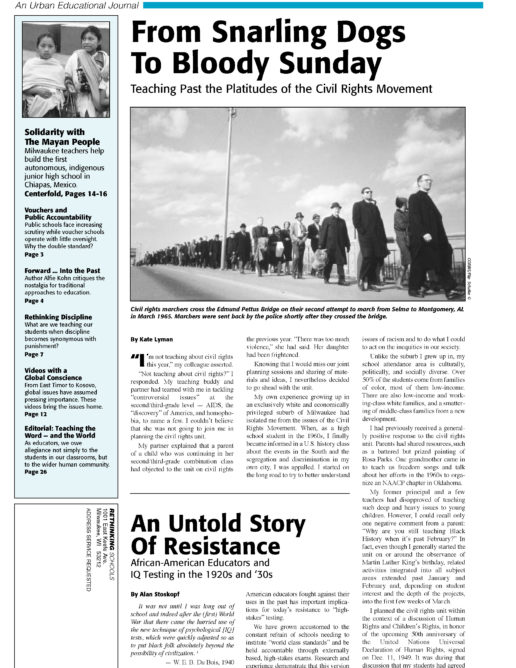Teaching the Word—And the World
Teachers need to help their students to understand their connection to peoples in need around the world – and to the earth itself.
As many of us who are teachers settled into our first faculty meetings this fall, we heard the usual pious statements about how our job is to “serve the children.” And, of course, it is.
But we need to broaden what we mean by this. Recent events around the globe remind us that serving the children requires that we try to make the world a better place. As educators, we can express our commitment to our students by serving the wider human community and the earth itself.
As we go to press, Indonesian soldiers and government-supported thugs have terrorized hundreds of thousands of people in East Timor. It’s only the most recent outrage in a place where, following the U.S.-sanctioned Indonesian invasion in 1975, the highest percentage of a people since the Nazi Holocaust has been slaughtered – mostly with U.S. weaponry. As we reported in Rethinking Schools last spring, an estimated one million Iraqi civilians have died since the U.S.-initiated sanctions; according to UNICEF, almost half the 250 daily deaths are children under five.
And it is not only war and sanctions that hurt people. Institutions like the International Monetary Fund and the World Bank have used the crushing Third World debt to demand “structural adjustment programs” -a neat, chiropractic-sounding term that masks the misery created by policies that throw millions of people off the land, cut wages, and slash social programs. Some of those displaced by these policies find jobs at pennies an hour in dangerous conditions in the sweatshops of multinational corporations.
This is all terrible, some might say, but what does it have to do with my students? Lots. First, they live in a country whose economic and political leaders make decisions that ripple through the world. For example, the U.S. exports more weapons than all other arms exporters combined. U.S. representatives have more say-so in world economic forums than those from any other country. Like it or not, U.S. policy makers speak in our names.
Our students live in a society that uses more resources than any other. “Our” model of development is exported around the world in movies, TV, and advertising of all kinds. Like a cancer, this system is based on unlimited growth; it cannot be sustained globally, and puts in peril our students’ futures.
From the food they eat, to the nature of their jobs, to the very climate itself, the processes of “globalization” hurtling forward affect our students in ways – many of them truly frightening – that link them to people around the world.
But all is not bleak. There are signs of hope everywhere: students around the country have staged successful protests against sweatshop labor; in Europe, organized efforts have blocked the import of genetically engineered “Frankenstein” foods, as they are called in the press there; Jubilee 2000 is a broad-based, thoughtful campaign linking debt-forgiveness with democratization of poor countries; and tens of thousands of protesters are expected to greet the World Trade Organization when it meets later this fall in Seattle.
Rethinking Schools has several articles in this issue that address some of these broader concerns. Editor Larry Miller spent time this summer in Chiapas, Mexico, building a school for indigenous people and learning about the Zapatista struggle. His articles begin on page 14. On pages 12-13, we excerpt part of “Videos with a Global Conscience,” a guide to valuable classroom resources that will be included in Bill Bigelow and Bob Peterson’s forthcoming book, Rethinking Globalization. A short article on page 21 lists phone numbers and web sites with information on the events surrounding the WTO meetings in Seattle.
When we consider student and school “success,” let’s not think only in terms of traditional academic success. The great Brazilian educator, Paulo Freire, insisted that students must learn not only to read the word, but also to read the world. Let’s ask whether or not we’re successfully equipping our students to understand their connection to people around the globe and to the ecosystems that all humans depend on. It’s time that our school communities resurrected that old union adage, “An injury to one is an injury to all.”
![]()
![]()

